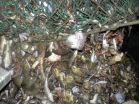(Press-News.org) JUPITER, FL, July 10, 2014 – Amidst the astounding complexity of the billions of nerve cells and trillions of synaptic connections in the brain, how do nerve cells decide how far to grow or how many connections to build? How do they coordinate these events within the developing brain?
In a new study, scientists from the Florida campus of The Scripps Research Institute (TSRI) have shed new light on these complex processes, showing that a particular protein plays a far more sophisticated role in neuron development than previously thought.
The study, published in the journal PLOS Genetics, focuses on the large, intracellular signaling protein RPM-1 that is expressed in the nervous system. TSRI Assistant Professor Brock Grill and his team show the surprising degree to which RPM-1 harnesses sophisticated mechanisms to regulate neuron development.
Specifically, the research sheds light on the role of RPM-1 in the development of axons or nerve fibers—the elongated projections of nerve cells that transmit electrical impulses away from the neuron via synapses. Some axons are quite long; in the sciatic nerve, axons run from the base of the spine to the big toe.
"Collectively, our recent work offers significant evidence that RPM-1 coordinates how long an axon grows with construction of synaptic connections," said Grill. "Understanding how these two developmental processes are coordinated at the molecular level is extremely challenging. We've now made significant progress."
Putting Together the Pieces
The study describes how RPM-1 regulates the activity of a single protein known as DLK-1, a protein that regulates neuron development and plays an essential role in axon regeneration. RPM-1 uses PPM-2, an enzyme that removes a phosphate group from a protein thereby altering its function, in combination with ubiquitin ligase activity to directly inhibit DLK-1.
"Studies on RPM-1 have been critical to understanding how this conserved family of proteins works," said Scott T. Baker, the first author of the study and a member of Grill's research team. "Because RPM-1 plays multiple roles during neuronal development, you wouldn't want to interfere with it. But exploring the role of PPM-2 in controlling DLK-1 and axon regeneration could be worthwhile—and could have implications in neurodegenerative diseases."
The Grill lab has also explored other aspects of how RPM-1 regulates neuron development. A related study, also published in PLOS Genetics, shows that RPM-1 functions as a part of a novel pathway to control β-catenin activity—this is the first evidence that RPM-1 works in connection with extracellular signals, such as a family of protein growth factors known as Wnts, and is part of larger signaling networks that regulate development. A paper in the journal Neural Development shows that RPM-1 is localized at both the synapse and the mature axon tip, evidence that RPM-1 is positioned to potentially coordinate the construction of synapses with regulation of axon extension and termination.
In addition to Grill and Baker, Erik Tulgren of the University of Minnesota, Willy Bienvenut of the Campus de Recherche de Gif, France, as well as Karla Opperman and Shane Turgeon of TSRI contributed to the study entitled, "RPM-1 Uses Both Ubiquitin Ligase and Phosphatase-Based Mechanisms to Regulate DLK-1 during Neuronal Development."
INFORMATION:
For more information, see http://www.plosgenetics.org/article/info%3Adoi%2F10.1371%2Fjournal.pgen.1004297
The first author of the study, "The Nesprin Family Member ANC-1 Regulates Synapse Formation and Axon Termination by Functioning in a Pathway with RPM-1 and β-Catenin," is Erik Tulgren of the University of Minnesota. Other authors include Shane Turgeon and Karla Opperman of TSRI. For more information, see http://www.plosgenetics.org/doi/pgen.1004481
The first author of the study, "RPM-1 Is Localized to Distinct Subcellular Compartments and Regulates Axon Length in GABAergic Motor Neurons," is Karla Opperman of TSRI. For more information, see http://www.neuraldevelopment.com/content/9/1/10
The work was supported by the National Institutes of Health (grant R01 NS072129) and the National Science Foundation (grant IOS- 1121095).
Scripps Florida scientists shed new light on nerve cell growth
2014-07-10
ELSE PRESS RELEASES FROM THIS DATE:
On the link between periodontitis and atherosclerosis
2014-07-10
Chronic oral infection with the periodontal disease pathogen, Porphyromonas gingivalis, not only causes local inflammation of the gums leading to tooth loss but also is associated with an increased risk of atherosclerosis. A study published on July 10th in PLOS Pathogens now reveals how the pathogen evades the immune system to induce inflammation beyond the oral cavity.
Like other gram-negative bacteria, P. gingivalis has an outer layer that consists of sugars and lipids. The mammalian immune system has evolved to recognize parts of this bacterial coating, which then ...
New research finds ocean's most abundant organisms have clear daily cycles
2014-07-10
Imagine the open ocean as a microbial megacity, teeming with life too small to be seen. In every drop of water, hundreds of types of bacteria can be found. Now scientists have discovered that communities of these ocean microbes have their own daily cycles—not unlike the residents of a bustling city who tend to wake up, commute, work, and eat at the same times.
What's more, it's not all about the sun. Light-loving photoautotrophs—bacteria that need solar energy to help them photosynthesize food from inorganic substances—have been known to sun themselves on a regular schedule. ...
Window of opportunity against HIV comes from 'fitness bottleneck'
2014-07-10
New research on HIV transmission shows that viral fitness is an important basis of a "genetic bottleneck" imposed every time a new person is infected. The findings define a window of opportunity for drugs or vaccines to prevent or limit infection.
HIV represents evolution on overdrive. Every infected individual contains a swarm of viruses that exhibit variability in their RNA sequence, and new mutations are constantly appearing. Yet nearly every time someone new is infected, this diverse population of viruses gets squeezed down to just one individual.
The genetic bottleneck ...
Study points to potential new target for antibiotics against E. coli, other bugs
2014-07-10
COLUMBUS, Ohio – Scientists have identified a protein that is essential to the survival of E. coli bacteria, and consider the protein a potential new target for antibiotics.
In the study, the researchers confirmed that this protein, called MurJ, flips a fatty molecule from one side of a bacterial cell membrane to the other. If that molecule isn't flipped, the cell cannot construct a critical layer that keeps pressurized contents of the cell contained. If those contents aren't contained, the cell bursts.
E. coli is part of the gram-negative family of bacteria, characterized ...
Cultured CTCs reveal genetic profile, potential drug susceptibility of breast cancer cells
2014-07-10
Circulating tumor cells captured with a microchip-based device developed at the Massachusetts General Hospital (MGH) Center for Engineering in Medicine and the MGH Cancer Center can be cultured to establish cell lines for genetic analysis and drug testing. In the July 11 issue of Science, an MGH research team reports that the cultured cells accurately reflect a tumor's genetic mutation over time and changing susceptibility to therapeutic drugs.
"We now can culture cells from the blood that represent those present in metastatic deposits, which allows testing for drug ...
Inherited 'memory' of environmental impact on health may be limited
2014-07-10
When a pregnant mother is undernourished, her child is at a greater than average risk of developing obesity and type 2 diabetes, in part due to so-called 'epigenetic' effects. A new study in mice demonstrates that this 'memory' of nutrition during pregnancy can be passed through sperm of male offspring to the next generation, increasing risk of disease for her grandchildren as well. In other words, to adapt an old maxim, 'you are what your grandmother ate'. The study also raises questions over how epigenetic effects are passed down from one generation to the next – and ...
Researchers harness a powerful new source of up-to-date information on economic activity
2014-07-10
ANN ARBOR--- Researchers at the University of Michigan, University of California Berkeley, and Arizona State University have developed a new data infrastructure for measuring economic activity.
The infrastructure uses aggregated and de-identified data on transactions and account balances from Check, a mobile payments app, to produce accurate and comprehensive measures of consumers' spending and income on a daily basis.
In a paper appearing in the July 11 issue of Science, economists Michael Gelman, Shachar Kariv, Matthew Shapiro, Dan Silverman, and Steven Tadelis ...
International science team solve biological mystery
2014-07-10
This news release is available in German.
An international team of researchers, led by the University of Leicester, has solved a long-standing mystery in biology, by identifying the molecular structure of a vital biological chemical. The debate – which has raged within the scientific community for years – boils down to something as simple as a hydrogen atom: is it there, or is it not?
The controversy centres around a form of enzyme called a heme (or haem, as in haemoglobin) at the centre of which is an iron atom (Fe) called a 'ferryl' which becomes oxidised when ...
Overfishing in the English Channel leaves fisherman scraping the bottom of the barrel
2014-07-10
Decades of overfishing in the English Channel has resulted in the removal of many top predators from the sea and left fishermen 'scraping the barrel' for increasing amounts of shellfish to make up their catch.
Sharks, rays, cod, haddock and many other species at the head of the food chain are at historic lows with many removed from the area completely.
These are some of the findings of a study led by marine biologists at Plymouth University, in association with international non-profit research organization WorldFish. They analysed catches over the past 90 years and found ...
Uncertainty gives scientists new confidence in search for novel materials
2014-07-10
Scientists at Stanford University and the Department of Energy's SLAC National Accelerator Laboratory have found a way to estimate uncertainties in computer calculations that are widely used to speed the search for new materials for industry, electronics, energy, drug design and a host of other applications. The technique, reported in the July 11 issue of Science, should quickly be adopted in studies that produce some 30,000 scientific papers per year.
"Over the past 10 years our ability to calculate the properties of materials and chemicals, such as reactivity and mechanical ...


